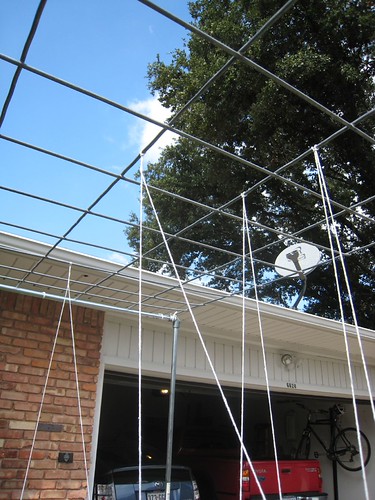
Installing Shutters, originally uploaded by espeedy123.
Here’s before, with yucky, crumbling old white plastic shutters:


Here’s the midway point, where we existed for a few months while the shutters were being fabricated:

And today, after I painted and installed the new ones:


These are custom vinyl shutters from ArchitecturalDepot.com that cost around $200 for two pair. I would have loved wood or composite ones, but they cost considerably more ($1,000+) and weren’t worth it to me as I think the end result is pretty good. Vinyl shutters from a hardware store cost even less than what I paid, but sizes are limited, and if you special order unusual sizes they will actually run more than what I paid online.
I also had a rather unusual problem of fitting these to the masonry that made it easier to work with vinyl. Let me explain. I feel like a lot of the cheap shutters I see are misproportioned. They are usually way too narrow to be even close to realistic. Given that a shutter’s original use was to cover the window, I feel like visually they look better and less like they came from Home Depot if they are closer to half the width of the window. The top, or soldier, row of masonry on my house has every fourth or fifth brick angling out at the bottom. That made it a challenge to fit these wider shutters.
I used metal snips and my Dremel with a coarse drum sander attachment to carve away enough of the back of the shutter for them to fit. Tedious, but worth the end result.

Another house in my neighborhood apparently has the same issue. The installer just moved the shutters down. Does this look goofy to anyone else?

Mine are paneled style shutters that I ordered with a primed finish. Paneled are supposed to be more formal than louvered or the trendy board-and-batten shutters that seem like they are everywhere. I wasn’t going for formal, but I figured that these would be easy to paint and also match my paneled wood front entry door. I used the same oil-based high gloss exterior house trim paint on them that I used for the posts. Benjamin Moore “briarwood,” specifically.
They are attached using plastic anchors called shutterloks. It’s important to get the mortar holes right the first time because the shutterloks will not come out without a ton of effort once they are hammered. I drilled the shutter holes first and then marked using a small thin paintbrush the exact drilling spot onto the mortar. I painted the anchors to match the shutters.
Would love to hear your thoughts on shutters!





























